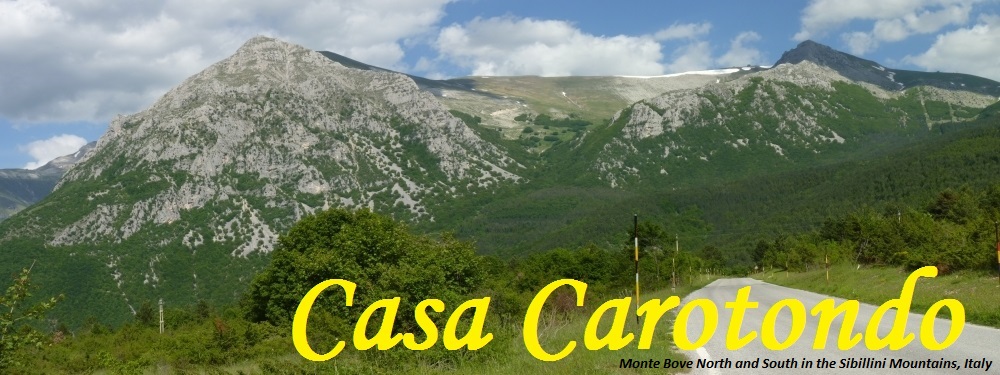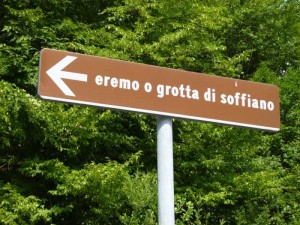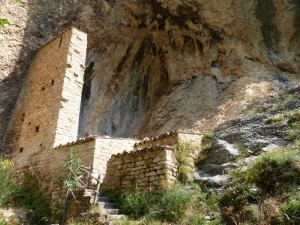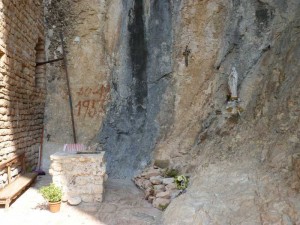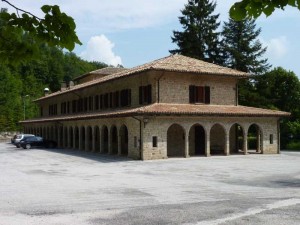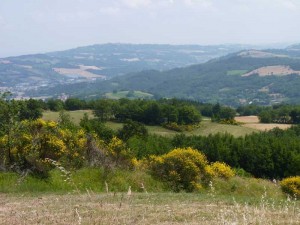While driving from Casa Carotondo to the Prati di Ragnolo (the meadows of Ragnolo) to look at the wild flowers and the views you will pass the Santuario di San Liberato. Shortly after that is a turning to the left with the signpost Eremo di Soffiano (the hermitage of Soffiano). You can park your car at the junction and take the easy walk to the hermitage. The path leads you into a steep valley with the river Terro flowing below. After about 30 minutes you will come across the remains of a cave that was used by Franciscan monks as a hermitage many centuries ago.
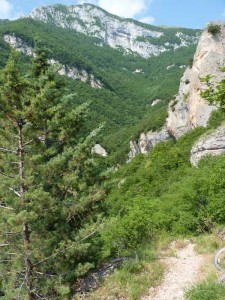
Walking towards the Eremo di Soffiano in the valley of the Terro river in the Sibillini Mountains, Le Marche, Italy
The hermitage was constructed in 1101 with the support of some wealthy lords on the request of local religious people wishing to live the life of hermits in the tradition of oriental monks. The hermitage would have been composed of a few rooms and a miniscule church. The Church was dedicated to St. Lorenzo. On one side rock constituted a natural wall, against which, other walls were built to make up the simple habitation. The roof was made of slabs of stone held up by rough hewn timber beams from the wood. In some parts of the remaining walls the holes are still visible where some say the beams were placed to hold the upper floor. A small altar and a stone with a cross remind the visitor of the sanctity of the place, while the partial reconstruction of some walls bring the mind to what could be the primary living space.
There are several theories to explain the name Soffiano. Some are convinced that it derives from Sufius the name of a former owner of the land. The hermitage is in what is known today as the Valle di Jana (Jana Valley). Janus, a deity was well known among the Italian population in those days and occupied the same position as Jupiter did for the Romans. Some theorize that the hermitage was built specifically in that place to eliminate the cult of the god Janus from the memories of the people in that area.
Popular stories claim that a hermit lived there all his life with a goat. Recently the bones of a man and an animal have been found. It was after the death of the first group of hermits that the Franciscans took over the place and possibly even Saint Francis himself lived here at the beginning of 1200. It is also from here that a celebrated episode from the Fioretti (“The Little Flowers” – accounts of the life of St. Francis written one hundred years after his death) takes place in which Brother Pacifico sees the soul of Brother Umile rise from his body on his death. Excavations carried out recently revealed the presence of graves with some bones and items of little value. Those tombs were almost certainly the resting place of the Blessed Umile and Saint Liberato and possibly also Simone d’Assisi.
It is thought the Eremo di Soffiano was probably abandoned around 1282 on the request of the Brunforte family, who offered the monks protection elsewhere. The monks transferred the body of Saint Liberato and his two fellow monks, Umile and Pacifico to what is now known as the Santuario di San Liberato, then it was a small church S Maria di Soffiano. In a document registered at Sarnano 21st November 1340 by the notary Marino Condy the hermitage of Jana is named. The document is evidence that by this time the Franciscans had abandoned the Eremo di Soffiano.
Saint Liberato is said to have come from the town of Loro and the powerful Brunforte family. It is thought he might have joined the hermitage of Soffiano after having met, and been inspired by, St. Francis to live in poverty and humility. His meeting is assumed to have been documented in the Fioretti in chapter 37, where a rich gentleman is mentioned as being accepted into the order by Saint Francis himself. Assumed to be the anonymous monk identified in chapter 47 of the Fioretti he died probably in 1234 in Soffiano after having a vision of the Madonna and three virgins surrounded by angels.
Around 1420 the church S Maria di Soffiano was partially demolished and a new monastry built dedicated to Saint Liberato. The Santuario was named after Liberato because of his great spirituality and strict adherence to the Franciscan way of life. It is still home to an order of monks, however visitors are welcome to eat in the excellent restaurant there. From here there are a couple of possible walks through the woods, the easiest being a nature trail of 2 kilometers. The other is the reasonably challenging Anello di San Liberato. There is a bicycle ride from this point, also called the Anello di San Liberato, passing through the village of Monastero – home to another monastry.
